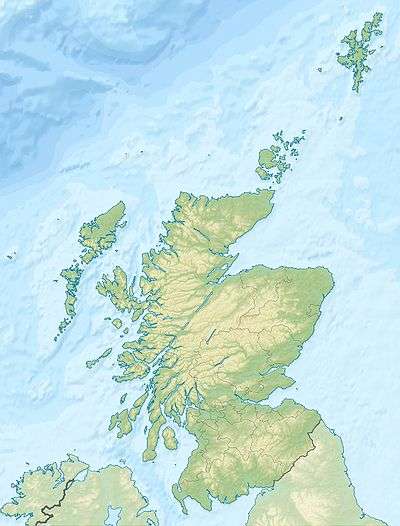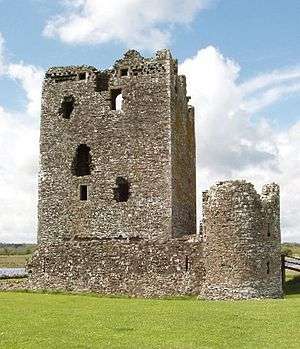Threave Castle
| Threave Castle | |
|---|---|
| Near Castle Douglas, Dumfries and Galloway, Scotland | |
|
Threave Castle from the southeast, looking from the across the River Dee | |
|
Threave Castle from the south, showing the curtain wall tower in front of the main keep | |
 Threave Castle | |
| Coordinates | 54°56′21″N 3°58′11″W / 54.9392°N 3.9697°W |
| Type | Keep |
| Height | 21m |
| Site information | |
| Owner | Historic Scotland |
| Controlled by | Earls of Douglas |
| Open to the public | Yes |
| Condition | Ruined |
| Site history | |
| Built | c.1370 |
| Built by | Archibald Douglas |
| In use | Until 17thC & again early 19thC |
| Materials | Stone |
Threave (or Thrieve, or Treve) Castle is situated on an island in the River Dee, 2.5 km (1.5miles) west of Castle Douglas in Dumfries and Galloway, Scotland. It was the home of 'Black' Douglas Earls of Douglas from the late 14th century until their fall in 1455.
History
The island was probably inhabited from the 6th century, and the name is most likely derived from the Old Welsh Tref, meaning homestead. It is possible that Fergus of Galloway built a timber castle on the island after 1000, but it was burned in 1308 by Edward Bruce.
Douglas stronghold
Threave Castle was built in the 1370s by Archibald Douglas, "the Grim", later the third Earl of Douglas, soon after he was created Lord of Galloway in 1369. A small collection of buildings was built around the main keep, including a hall and chapel. Threave Castle became Archibald's stronghold and he died there in 1400. His son Archibald married Princess Margaret, daughter of Robert III of Scotland.
Archibald Douglas, 5th Earl of Douglas, was appointed Regent to the infant King James II in 1437. Archibald died in 1439 and in the ensuing power struggle his 16-year-old son William was murdered at Edinburgh Castle, in 1440. Threave passed, with the Lordship of Galloway, to his sister Margaret, the "Fair Maid of Galloway".
William Douglas, 8th Earl of Douglas married Margaret, his cousin, in order to retrieve Galloway for the Douglases. He began a series of improvements to the Castle's fortifications in 1447, demolishing the earlier outbuildings and constructing a defensive wall along the river bank closest to the keep. In 1452 Patrick Maclellan of Bombie was imprisoned and murdered by the 8th Earl, against the order of James II. The deed was reciprocated the same year, when James II murdered William Douglas at Stirling Castle.
William's brother James Douglas, now 9th Earl, hastily continued the additions to Threave, building a curtain wall with three corner towers and a gatehouse, as well as an outer ditch and an earth rampart to the north of the keep. After his brother's murder, he intrigued with the English court, receiving money from Henry VI's government for the works. The 9th Earl's uprising was defeated at the Battle of Arkinholm near Langholm and his strongholds were systematically besieged. Threave Castle was subject to a two-month siege in 1455. The castle survived the attack and only succumbed when the garrison was bribed and promised safe conduct.
One story associated with the siege, which is repeated by Nigel Tranter, is that the great cannon Mons Meg was built in Kirkcudbright, by a smith named Mollance, for the Maclellans. The cannon was presented to James II and employed against Threave. The first cannonball fired supposedly smashed through the castle, taking off Margaret Douglas' hand as she drank. However, the undamaged state of the keep, and the alternative provenance of Mons Meg via Burgundy render these details dubious. Some of the King's artillery was used at Threave, as recorded in the Exchequer Rolls;
For the expenses made by Brother Andrew Lisours,carpenter, and John Were, burgess of Linlithgow, in the carriage of the Great Bombard to the siege of Threave, and its return to Linlithgow, £59 eighteen pence. For wood cut to its mountings, for iron and stones, coals, wedges and spades, £22 four pence. And for a pair of wheels used to bring the bombard from Threave to Linlithgow, 14 shilling four pence.[1]
Royal fortress
The castle was annexed by the Crown, and a succession of keepers appointed, although it is unlikely that the castle was again used as a residence. In 1513, Robert Maxwell, 5th Lord Maxwell, was appointed keeper following the death of the previous keeper, John Dunbar of Mochrum, at Flodden. In 1526 the position was made hereditary to the Maxwells (later Earls of Nithsdale).
In 1542, Robert Maxwell was captured after the battle of Solway Moss, and forced to hand Threave over to the English invaders. It was retrieved for Scotland by the Earl of Arran in 1545.
During the Bishops' Wars of 1638-1640, the Maxwells supported Charles I of England. A garrison of up to 100 men was installed and a grassy embankment was added to the Castle's defences. The castle was besieged by the Covenanters, and capitulated after 13 weeks. The buildings were partially dismantled, although the keep remained standing.
During the Napoleonic Wars in the early 19th century, Threave was used for a brief period to house French prisoners of war. In 1913 the owner, Edward Gordon, passed the castle into State care. It is now a Scheduled Ancient Monument cared for by Historic Scotland, and can be visited by boat. There is a car park, toilets and a building containing a display.
Castle
Threave Castle's rectangular keep is 21 m (69 ft), or 5 storeys high, and 18.4 by 12.1 m (60 by 40 ft) in plan. The keep was once accessed by a movable bridge from the gatehouse to the first floor. This level is vaulted, and was occupied by kitchens. Below is a basement with a well and prison pit. A spiral stair within the 2 m (6 ft 7 in) thick wall leads up to the great hall, which had a second bridge access to the upper gatehouse. Above this were two timber floors, now missing, with two rooms on the next storey, and servants quarters at the top. Holes in the external walls would have supported a timber defensive structure known as a bretache, which allowed the defenders to drop objects on attackers at the walls.
The keep is enclosed by the later curtain wall, which has round towers on its three corners, and a series of arrow loops and gun ports which were added when artillery began to play a significant role in warfare. Only one of these towers, the south east, remains, along with the gatehouse, which was formerly equipped with a drawbridge. The curtain walls are only 4.4m from the keep, and are surrounded by a once flooded ditch. To the west the river runs close to the keep. The remains of a wall survive along the river bank, curving back to the north west corner of the keep. A gated harbour was constructed here to provide secure alternative access to the castle. To the north, only an earth bank defends the keep, although the marshy approach to this side would have discouraged attackers.
The island itself covers 8 hectares (20 acres), although in the 15th century it is estimated to have been only a third of this size. However, the isle would have supported subsidiary buildings, such as stores and workshops, as well as the castle. Access was by boat or via a ford at the south of the island.
Proverb
There is a Scottish proverb: "Every man's man had a man and that made Treve fall". The origin of this proverb is the following story: the governor of Threave Castle left a deputy and he a substitute by whose negligence the castle was taken and burned. The meaning of the proverb is that when people employ other people to do the business that they were entrusted with, often both neglect it.[2]
References
- Coventry, Martin The Castles of Scotland (3rd Edition), Goblinshead, 2001
- Gifford, John The Buildings of Scotland: Dumfries and Galloway, Penguin, 1996
- Lindsay, Maurice The Castles of Scotland, Constable & Co. 1986
- Salter, Mike The Castles of South West Scotland, Folly Publications, 1993
- Tranter, Nigel Tales and Traditions of Scottish Castles Macdonald, 1982
External links
- ↑ Accounts of the Lord High Treasurer of Scotland, vol.1, Edinburgh (1877), p. ccxcix, (Latin), quoted from Exchequer Rolls (abbreviated here).
- ↑ James Kelly. A complete collection of Scottish proverbs: explained and made intelligible to the English reader, 1721

